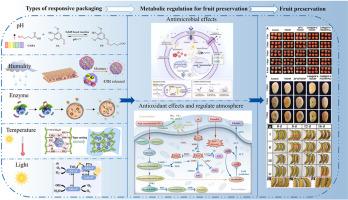Responsive packaging that adapted to and regulated physiological metabolic of fruits and vegetables: Mechanism, application and prospects
IF 15.4
1区 农林科学
Q1 FOOD SCIENCE & TECHNOLOGY
引用次数: 0
Abstract
Background
Postharvest fruit and vegetable losses are a serious problem. However, as living organisms, it is difficult for conventional packaging to adapt to fruit physiological metabolism to provide a suitable storage environment. Therefore, it is necessary to study the responsive packaging that can adapt and regulate the physiological metabolism of fruits and vegetables to effectively reduce their losses.
Scope and approach
This paper summarized the response types of packaging and conducted a systematic review of its preservative effects through the “stimulus-response-metabolism-quality” framework. It also analyzed the future prospects and limitations of responsive packaging in fruit applications.
Key findings and conclusions
Responsive packaging can not only dynamically adjust the microenvironment inside the package to adapt to the physiological metabolism of fruits, but also regulate fruit and vegetable metabolism by responsively releasing bioactive substances (such as essential oils, phenolic compounds, and aldehydes) to inhibit microbial reproduction and by dynamically regulating of gas composition (such as ethylene levels and CO2/O2) inside the packaging to regulate fruit metabolism to delay fruit senescence. This demonstrated the potential of responsive packaging to preserve fruit and vegetables in the future.

适应和调节果蔬生理代谢的响应包装:机理、应用与展望
果蔬采后损失是一个严重的问题。然而,作为生物体,常规包装难以适应果实的生理代谢,提供适宜的贮藏环境。因此,有必要研究能够适应和调节果蔬生理代谢的响应包装,以有效减少果蔬的损耗。本文通过“刺激-反应-代谢-质量”的框架,总结了包装的反应类型,并对其防腐效果进行了系统综述。分析了响应式包装在水果中的应用前景和局限性。响应式包装不仅可以动态调节包装内的微环境以适应水果的生理代谢,还可以通过响应性释放生物活性物质(如精油、酚类化合物、通过动态调节包装内气体成分(如乙烯水平和CO2/O2)来调节果实代谢,延缓果实衰老。这证明了响应式包装在未来保存水果和蔬菜的潜力。
本文章由计算机程序翻译,如有差异,请以英文原文为准。
求助全文
约1分钟内获得全文
求助全文
来源期刊

Trends in Food Science & Technology
工程技术-食品科技
CiteScore
32.50
自引率
2.60%
发文量
322
审稿时长
37 days
期刊介绍:
Trends in Food Science & Technology is a prestigious international journal that specializes in peer-reviewed articles covering the latest advancements in technology, food science, and human nutrition. It serves as a bridge between specialized primary journals and general trade magazines, providing readable and scientifically rigorous reviews and commentaries on current research developments and their potential applications in the food industry.
Unlike traditional journals, Trends in Food Science & Technology does not publish original research papers. Instead, it focuses on critical and comprehensive reviews to offer valuable insights for professionals in the field. By bringing together cutting-edge research and industry applications, this journal plays a vital role in disseminating knowledge and facilitating advancements in the food science and technology sector.
 求助内容:
求助内容: 应助结果提醒方式:
应助结果提醒方式:


